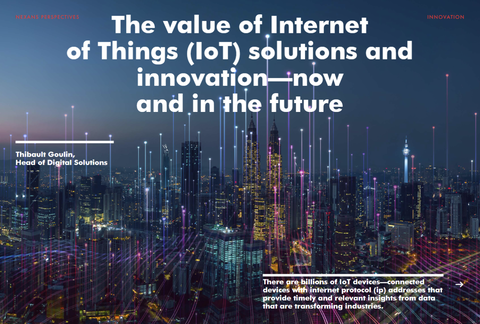There are billions of loT devices - connected devices with internet protocol (IP) addressed that provide timely and relevant insights from data that are transforming industries.

For example, connected appliances, smart home security systems, autonomous farming equipment and wearable health monitors to name a few. And the benefits of using IoT devices to companies are substantial which include reducing costs, optimizing performance, and increasing productivity.
“The benefits of using IoT devices to companies are substantial which include reducing costs, optimizing performance, and increasing productivity.”
At Nexans, IoT technology is used to help our customers track cable drums, a connected solution, in order to reduce losses and material theft, and to control cable drum rent and storage costs. Going further, by making them “smart and enhanced”, with the addition of a GPS system and a 3D accelerometer with embedded intelligence, customers can remotely determine how much cable is left on each drum for supply management improvements.
In addition, field staff can access the data of any drum using a smartphone or an RFID reader, since RFID tags are integrated into the drum during manufacturing. Product data sheets are included in the information stored in the drum’s tag, which helps those that working in a warehouse or on a building site to easily identify the type of cable, its use, and the rules to follow.
For Nexans customers, this means improved management of drum logistics and faster return of empty drums. It’s an entirely new business model and service being offered to our customers. The connected solution is powered by Microsoft Azure, which provides the hosting and security for IoT data.
Beyond transportable products, Nexans also provides connected solutions for companies’ fixed assets. The Infrabird™, another IoT technology-enabled solution, enables customers in the telecom and energy sectors to remotely monitor the state of street cabinets and other equipment to improve public services and decrease fault response time

Rapid emergence of edge computing
The benefits of IoT are supported by major trends such as cloud computing and artificial intelligence (AI). Combining these technologies has given rise to edge computing—a distributed computing paradigm that brings computation and data storage closer to the location where it is needed, allowing sensor data to be managed locally. Edge computing works to handle decentralized information processing, close to the company’s assets, without having to use remote servers each time—sometimes located hundreds or thousands of miles away.
In this scenario, IoT sensors can “think by themselves,” thanks to AI solutions and sophisticated algorithms capable of identifying standard situations. This extension of the cloud, which is another service supported by Microsoft Azure, gives companies the opportunity to deploy services as close as possible to their assets, and to develop them according to their specialized needs. Localized data processing also brings increases in speed for companies, with less lag time between action and results. However, this also means an increase in energy and bandwidth. With a rapid increase in the number of IoT sensors worldwide, such decentralized processing is set to grow exponentially. The company will ultimately contribute to boosting the power, efficiency, and profitability of IoT.

Transforming infrastructure
The mass deployment of connected objects, which are becoming increasingly powerful and intelligent through edge computing, has implications for the infrastructure of companies, and the way in which they design products and manage assets. One of Nexans’s most exciting projects is the creation of a complete digital ecosystem, potentially bringing together a company’s connected assets to form a “digital twin” a digital model capable of monitoring a company’s entire infrastructure, based on IoT sensors that provide accurate, real-time data for lean management.
The design of this digital twin opens up unprecedented possibilities in manufacturing and identifies business opportunities for Nexans. It will help managers to make the best possible choices when it comes to ergonomics, design, and increased performance of products and services. Based on past data and behaviour, companies can conduct precise simulations to identify risks and implement predictive and preventative maintenance. In 2019, Nexans launched the Asset Electrical service, which provides companies in the utilities sector with decision-making support, to better manage the maintenance and renewal of their assets.
“Design of this digital twin opens up unprecedented possibilities in manufacturing and identifies business opportunities.”
Union of IoT and mixed reality
Other technological developments are also in progress, such as mixed reality. Nexans and Microsoft are currently working together on HoloLens 2 mixed reality headsets, with the goal of providing new services like remote support and training.
IoT data and digital twins can also help develop augmented-reality training modules, that simulate realistic scenarios around building security, for example. Simulations are projected onto the headset, immersing the wearer in any situation as desired. New recruits can rehearse a dangerous situation, as many times as necessary, in a safe virtual space until they remember the correct actions and procedures to perform.
These technologies will be used to make manufacturing facilities more reliable and secure, and reinforce the protection of those working in potentially dangerous situations—whether they are employees or service providers. Looking ahead, Nexans envisions 3D mapping of production sites to design made-to-measure machines before they are installed, and remotely visualize the production line to better understand the malfunctions reported by IoT sensors; the possibilities are endless. “Design of this digital twin opens up unprecedented possibilities in manufacturing and identifies business opportunities.”
